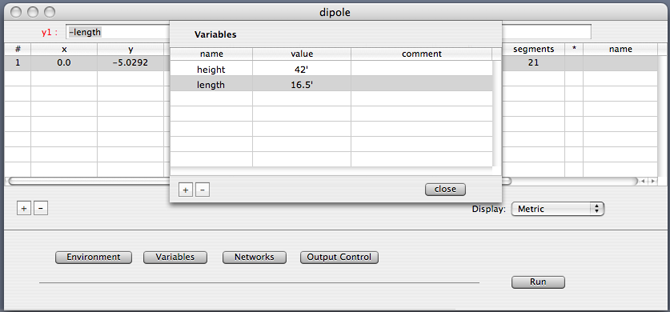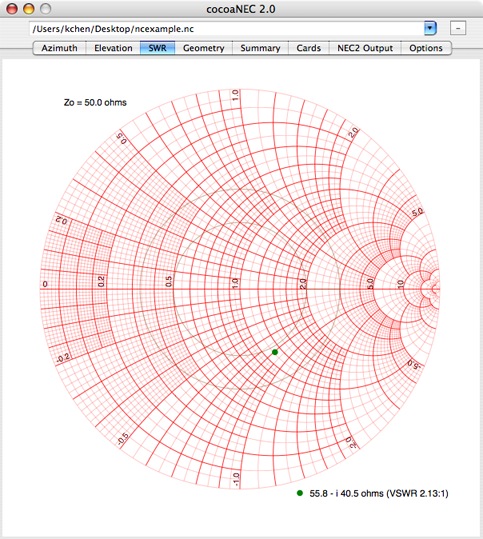
cocoaNEC 2.0 Manuals
Kok Chen, W7AY
[w7ay (at) arrl (dot) net]
Last edited: January 10, 2012
Introduction
cocoaNEC 2.0 is a Mac OS X application intended
primarily for the design and modeling of antennas.
cocoaNEC uses the Mac OS X Cocoa framework and is a Universal
Binary application.
Both the cocoaNEC 2.0 application and the Xcode project and
sources are free.
Both the application and the Xcode sources can be
downloaded by visiting the main cocoaNEC page (the cocoaNEC tab
button at the top of this page). Or go directly to
here.
cocoaNEC uses NEC-2 as the compute engine. It is
highly recommended that you have a copy of the NEC-2
reference documentation nearby. The reference can be
found both in html and pdf formats.
cocoaNEC can also use NEC-4. The NEC-4 reference
documentation comes in the same distribution CD-ROM that
contains the NEC-4 sources.
Antenna Models
cocoaNEC provides two separate input methods for describing
an antenna model. One uses a tabular ("spreadsheet") input
method and the other uses a programming language.
You can also import from and export to NEC-2 "card decks."
In addition, you can directly import output from nec2c and
NEC-4 to display in cocoaNEC's graphical back end. cocoaNEC
can also directly use a non-embedded copy of NEC-4, but
because of licensing requirements, you will need to compile
NEC-4 yourself (instructions are here).
The Spreadsheet tab button at the top of this page
takes you to the tutorial on the tabular method
and the NC tab button takes you to the tutorial on the programming method. These
tutorials provide quick introductions.
For details, please refer to the Reference Manuals. The
Ref. Manual tab button at the
top of this page takes you to the reference pages for
functionality that is common to both of the two input
interfaces. The part of the reference manual that is
specific to the spreadsheet interface can be found in
Ref. Manual II. The part of
the reference manual that is specific to the NC language
can be found in in Ref. Manual III.
If you are fluent with computer programming, you might find
the programming method to be both a more natural way to
describe an antenna and a faster way to generate the
models. The "programming" method also permits you to write
automatic optimizers, whereas you'd have to manually
manipulate the input data when using the "spreadsheet"
method.
System Requirements
cocoaNEC 2.0 works with either Intel or PowerPC based
Macintosh computers that run Mac OS X 10.4 (Tiger) or
newer. The Snow Leopard version of cocoaNEC 2.0 requires
Mac OS X 10.6 (Snow Leopard) or Mac OS X 10.7 (Lion) to run
on.
What cocoaNEC does
cocoaNEC turns an antenna description into a "card deck"
that is passed on to the NEC engine. A card deck contains
text images of the Hollerith cards which the NEC engine
uses as input.
After NEC-2 or NEC-4 finishes processing the input card
deck, cocoaNEC distills the line-printer output from the
NEC program and presents the data in forms that are easier
to visualize.
The following shows a few "cards" from a typical NEC-2
input card "deck":

and the following shows a few lines from a typical NEC-2 output file:

With the cocoaNEC 2.0 spreadsheet interface, instead of describing the antenna using a "card deck," your input will instead look something like this:

and your output will look like
this:

In the case of the cocoaNEC
programming language, the NC "program" which produces the
same antenna model would look like this:

Files
When you install cocoaNEC 2.0, the application will be
placed in the /Applications folder. No other files are
copied to your hard drive.
After you run cocoaNEC, a file named w7ay.cocoaNEC 2.0.plist
will appear in your home directory's Library/Preferences
folder. Currently, the plist file contains lists of the
antenna models that were most recently used by cocoaNEC
(this allows the Open Recent... menu items to find
the files). The plist file also contains user preferences
that are set from the Output Window.
When you run the antenna models, temporary files are
created in the /tmp directory. The temporary files used for
NEC-2 input are called necinputNN.dat and the
output from the NEC-2 engine is written to files that are
called necoutputNN.txt. If you
need to see what they look like, just use the Unix terminal
in Mac OS X and connect to the /tmp directory. The NN are
sequence numbers starting at 1 for each time that you
launch cocoaNEC.
You can download some example files that might be
helpful. (Use the Example tab buttons above.)
Development History
Not finding a native antenna design program for MacOS X, I
had started the original cocoaNEC (1.0) project back in
2002 as a Cocoa GUI around the NEC-2 program. The FORTRAN code for NEC-2 was originally
translated automatically into C with the f2c program. The old cocoaNEC had
used an interpreter (an earlier version of NC) as the
sole means of describing antenna geometry.
cocoaNEC 2.0 is a major rewrite of the original
application. In addition to extending the NC interpreter, I
have added a spreadsheet-like interface for entering
antenna models. Even though it supports variables and
mathematical functions, the spreadsheet interface is still
much less powerful than the NC interface, and the use of
the spreadsheet interface in cocoaNEC is discouraged.
However, the spreadsheet interface may be easier than the
NC interface for a non-technical user to learn. cocoaNEC
2.0 was started in August 2007
Instead of the original NEC-2 engine, this newer cocoaNEC
2.0 uses a compute engine that has since been made
available, called nec2c.
nec2c was manually translated from FORTRAN into C by
Neoklis Kyriazis, 5B4AZ (see below) and the code runs
substantially faster than the machine translation of NEC-2
by f2c. cocoaNEC 2.0 uses the nec2c.rxq variant of nec2c.
cocoaNEC 2.0 can also use the NEC-4 engine.
Acknowledgments
cocoaNEC 2.0 uses the public domain nec2c.rxq code as its
embedded compute engine.
nec2c.rxq is the work of Jeroen Vreeken, PE1RXQ, and it is
based on the earlier nec2c program by Neoklis
Kyriazis, 5B4AZ.
nec2c was translated from the original NEC-2 program that was
developed by Jerry Burke and A. J. Poggio of the
Lawrence Livermore Labs.
NEC-2, nec2c and nec2c.rxq are all free for anyone to use.
cocoaNEC would not have been possible without the generous
contributions of the above people.
My grateful thanks to the
alpha testers who I have discussed the program with, and
who have fed back bug reports and documentation errors:
Doug K4DSP, Duffey KK6MC/5, Steve WB6RSE and especially
Russ AA7QU, without whom this manual would have been much
more difficult to read. Bill, K1GQ prodded me to add
important features, and also helped with tracking down a
re-entrancy problem in the Sommerfeld ground model of
nec2c. Bill further collaborated with me to get NEC-4
working on cocoaNEC.
All remaining bugs in
the program, and errors in the documentation remain my
fault, of course.
Next :Spreadsheet Tutorial
Next: Programming Language (NC) Tutorial
Back to: cocoaNEC (downloads, etc)